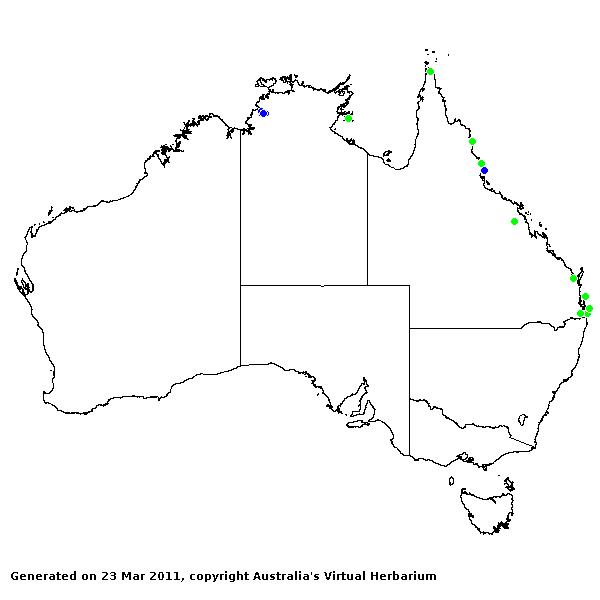Saccharum* Sp. Pl. 54 (1753).
Derivation:. From Latin saccharum (sugar), alluding to the sweet juice of the culms.
Syn: Erythranthera Zotov.
Taxonomic revisions, nomenclatural references:. J.W.Vickery, Contr. New South Wales Natl Herb. 2: 249–325 (1956) (as Danthonia); H.E. Connor and E. Edgar, New Zealand Journal of Botany 17, 311–337 (1979); S.W.L.Jacobs, Taxon 31: 737–743 (1982); H.P.Linder, Telopea 6: 597–627 (1996).
Key references (keys and floras):. E.E.Henty, Manual Grasses New Guinea 166–168 (1969); M.Lazarides, Tropical Grasses S.E. Asia 67–69 (1980); B.K.Simon, Key to Australian Grasses 154 (1993); D.Sharp and B.K.Simon, AusGrass (2002); S.W.L.Jacobs, R.D.B.Whalley & D.J.B.Wheeler, Grasses of New South Wales, 4th ed, 363 (2008).
W.D.Clayton & S.A.Renvoize, Genera Graminum (1986), genus (568).
Native and naturalised. 5 species, from tropical and subtropical regions. 2 species in Australia, NT and Qld. Also New Guinea and Malesia.
Habit. Robust perennial (cane grasses), rhizomatous. Culms woody and persistent, or herbaceous. Leaf blades broad or narrow, hard, woody, needle-like (rarely) or not needle-like (often disarticulating). Ligule a fringed membrane.
Inflorescence. Inflorescence paniculate, an open panicle with branches ending in single spikelets, open (plumose, silvery). Spikelet-bearing axes spiciform racemes, with homomorphic spikelets, disarticulating at joints. Internodes disarticulating transversely, densely long-hairy to somewhat hairy.
Spikelets. Spikelets laterally compressed or subterete or dorsally compressed, 2 flowered, with 1 fertile floret, paired, sessile and pedicelled, in pedicelled/sessile combinations; with naked rachilla extension; with lower incomplete floret. Fertile spikelets cuneate or obovate, green to purple, laterally compressed, falling with glumes (the pedicelled falling from the pedicel, the sessile falling with the joint and pedicel).
Glumes. Glumes more or less equal, shorter than spikelet or about equal to spikelet or exceeding florets, long relative to adjacent lemmas, usually hairy or hairless (rarely), scabrous, without conspicuous tufts or rows of hairs, pointed (acute), awnless, similar. Lower glume more or less two-keeled (in sessile spikelets) or not two-keeled (in pedicellate spikelets), convex on back or flattened on back, relatively smooth, 5–7 nerved. Upper glume 5–7 nerved.
Florets. Lower incomplete floret(s) sterile. Lemmas awnless, not becoming indurated. Fertile florets 1. Lemmas membranous, or reduced to a linear stipe, less firm than glumes, not becoming indurated, entire at apex, pointed or blunt, deeply cleft or not deeply cleft, mucronate or awned, 0–1 nerved, with nerves confluent towards tip, hairy. Awns 1 (bristle-like), the median different in form from laterals (when laterals present), apical, non-geniculate, much shorter than body of lemma to much longer than body of lemma. Lateral awns (when present) shorter than median to about equalling median (straight, terminating the lobes as setae). Lemma hairs when present (as is usual), in tufts, in transverse rows (with transverse rows of tufts or marginal tufta) or not in transverse rows (villous). Palea present or absent, when present relatively long or conspicuous and relatively short or very reduced, entire (truncate) or apically notched (minutely bilobed), thinner than lemma, nerveless, 2 keeled, glabrous or hairy. Palea keels wingless, scabrous. Distal incomplete florets underdeveloped. Callus short, blunt. Lodicules 2. Stamens 3. Stigmas 2. Disseminule a caryopsis enclosed in but free of lemma and palea. Grain small, golden-brown, obovate, longitudinally grooved (or somewhat hollowed), terete, glabrous. Hilum short. Embryo large or small. Pedicels free of rachis.
Kranz Anatomy. C4, biochemical type NADP-ME (S. officinarum).
2n = 40 or 60 or 68 or 76–78 or 80 or 90 or 46–128 or 110 or 112 or 116–117 or 144, 4, 6, 8, 9, and 12 ploid.
Habitat. Helophytic, mesophytic. Mostly riversides and valleys, some on open hillsides. Shade species, or species of open habitats.
Classification. Panicoideae; Andropogoneae.
Notes. Saccharum is commonly split into several genera, but the characters relied on are more appropriate to infra-generic categories (Clayton and Renvoize, 1986).
Types Species. S. officinarum L.
Biogeographic Element. Clifford & Simon 1981, Simon & Jacobs 1990: Naturalised.


